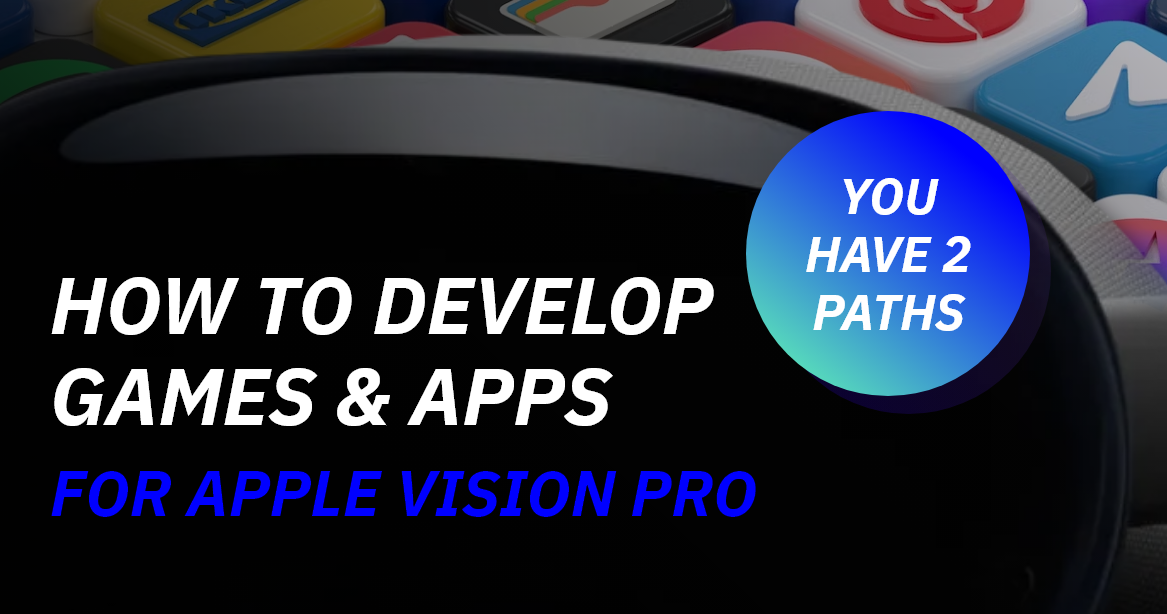 Search
Search

For a quick surf through the article:
- Mixed Reality: Bounded and Unbounded Volumes
- Expanding Game Possibilities
- 2 Game Development Paths for Apple Vision Pro
- Captivating the Non-gamer Part of the Audience
- Summing up
The recent announcement of Apple Vision Pro technology has sent shockwaves through the game industry, leaving a lasting impact on developers, enthusiasts, and consumers alike.
Walla Walla Studio has recognized the immense game industry opportunities in using the power of Apple Vision Pro from the first days the technology is revealed. With its advanced capabilities and cutting-edge features, Apple Vision Pro is ideal for creating visually stunning and immersive game experiences.
As a full-cycle game art production company, Walla Walla Studio sees the potential to leverage this technology to push the boundaries of art creation, delivering top-notch quality and moving the industry forward. That’s why we’re happy to unlock new creative game industry possibilities in this article.
Mixed Reality: Bounded and Unbounded Volumes
The Apple Vision Pro introduces two distinct ways of experiencing mixed reality: bounded volumes and unbounded volumes.
Bounded volumes refer to a defined space where virtual objects interact with the physical world, such as a robot roaming on a desk. Unbounded volumes, on the other hand, offer limitless possibilities, allowing games to extend seamlessly throughout an entire room.
These varying volumes open new avenues for game development, providing unprecedented contexts and inputs that transform ordinary spaces into dynamic gaming environments.
Expanding Game Possibilities
If you are accustomed to developing mobile or 2D games then now you have the opportunity to create experiences where a dining room table or any other real-world surface becomes a virtual playground.
For example, a virtual board game with magical portals appearing on a desk or objects flying out of them becomes a feasible concept. The combination of environmental context and intuitive hand and eye inputs unlocks new gameplay experiences for you, like how touch screens revolutionized mobile gaming.
Balancing Audience Reach and Investment
While the potential for groundbreaking experiences exists, you must consider the balance between audience reach and investment first. Creating a game exclusively for a niche market may not yield the desired return on investment.
However, by developing a smart strategy, you can ensure your app runs not only on the Apple Vision Pro but also on iPads and iPhones. Although the experience may differ, it allows a broader audience to engage with approximately 80% of the game. This approach maximizes accessibility while reserving the premium aspects for those using the Apple Vision Pro.
2 Game Development Paths for Apple Vision Pro
We now face two primary development paths when considering the Apple Vision Pro.
- The first path involves targeting the entire iOS ecosystem, including iPads and iPhones while incorporating additional spatial content specifically for the Apple Vision Pro.
This approach ensures a broader reach and allows users across various Apple devices to enjoy the game.
If you already have an app designed for iPad or iPhone, the good news is that running it on the Apple Vision Pro requires minimal effort. By downloading the latest version of Xcode, developers can preview how the app will appear on the device. In its default state, the app will function as expected on the Apple Vision Pro.
However, Apple offers additional suggestions to enhance the app’s spatial experience, enabling developers to leverage the ornament API or create floating menus for improved aesthetics.
While the primary goal is to ensure that the app runs seamlessly on the Apple Vision Pro, developers are encouraged to identify key moments where spatial enhancements would make sense.
For example, an app for a hotel company or Airbnb may benefit from a spatial gallery view. Users can browse through hotel images spread out around them, creating a captivating and immersive experience. By focusing on one significant spatial moment, developers can leverage the unique capabilities of the Apple Vision Pro without requiring extensive modifications to the entire app.
Apple’s guidance emphasizes the importance of ensuring that the app maintains its functionality on the Apple Vision Pro. You should prioritize delivering a seamless user experience, regardless of the device being used. While spatial enhancements can be valuable, they should be thoughtfully integrated into the app’s core functionality rather than being the sole focus of your development efforts.
- The second path focuses on building fully immersive experiences for all VR headsets.
In this scenario, you may prioritize Unity as your development engine, enabling you to create games that transcend the iOS ecosystem and deliver captivating experiences across multiple VR platforms.
While waiting for the Vision Pro sales openings, you can start building a Unity to another headset of a similar budget category. For example, for the Varjo XR-3. It can be compared to the Vision Pro headset. While it’s not as good as the Vision Pro, it comes quite close in terms of features.
One of the XR-3’s standout features is its full-color pass-through capability, allowing you to see the real world while using the headset. It also boasts a high-resolution display that offers impressive room-tracking and hand-tracking capabilities.
The demand for Apple Vision Pros among developers seems to exceed the available supply. If you have the budget, you can opt for the XR-3 or consider a Quest Pro as an alternative. It’s worth trying out the XR-3 setup or even the Quest Pro to get a firsthand experience of their capabilities. Moreover, with Unity integration, you can create applications specifically tailored for the XR-3 or Vision Pro, enabling you to explore the potential of these devices.
Overall, the XR-3 offers a compelling option for those with the means to afford it, while the Quest Pro and Vision Pro provide viable alternatives depending on your budget and development needs. The integration with Unity allows you to gradually transition to Vision Pro, enhancing your workflow and expanding your creative possibilities in the process.
Captivating the Non-gamer Part of the Audience
There is a growing trend of non-gamers purchasing VR devices for entertainment purposes such as streaming Netflix or HBO. These people, while not necessarily gamers, after buying an Apple Vision Pro may develop an interest in exploring additional content available on the platform. So there will be an increasing demand for casual games that cater to this audience by offering simpler gameplay experiences that do not require excessive physical movement.
When considering the risks associated with developing games for specific platforms, it is crucial to recognize that creating a game exclusively for a single platform may limit its market potential.
For instance, if a game is designed solely for a mixed-reality platform that supports interactive experiences in a user’s room, the target audience will be restricted to users of that particular platform. However, by diversifying development efforts to include iOS and iPad versions of these experiences, you can expand your reach and accessibility to a broader range of users.
Summing up
The unveiling of Apple Vision Pro technology has undoubtedly made a significant impact on the gaming industry. The introduction of Apple’s headset is expected to broaden the potential user base for AR/VR games, prompting developers to adapt by creating more casual and accessible gaming experiences.
Furthermore, the compatibility of existing iPad and iPhone apps with Apple Vision Pro provides a seamless transition for developers, with the opportunity to enhance spatial elements and create immersive moments within their applications.
The future of the gaming industry holds great promise with the emergence of Apple Vision Pro, and Walla Walla Studio remains at the forefront, ready to harness its potential. Contact us to acquire revolutionary artwork that will elevate your AR/VR game experiences and prepare you to shine!


